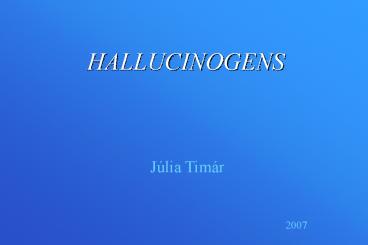1. dia - PowerPoint PPT Presentation
1 / 38
Title:
1. dia
Description:
Those drugs used to be considered hallucinogens in the action of which dominant ... hallucinogen persisting perception disorder (HPPD) flashback. convulsions ... – PowerPoint PPT presentation
Number of Views:96
Avg rating:3.0/5.0
Title: 1. dia
1
HALLUCINOGENS
Júlia Timár
2007
2
States in which hallucination can develop
- mental disorders (schosophrenia, delirium, etc)
- high fever (e.g. typhus)
- pharmacons (e.g. heart gylcosides,
glycocorticoids, anticholinergic drugs)
- drugs of abuse
3
HALLUCINOGENS
Those drugs used to be considered hallucinogens
in the action of which dominant symptoms are the
hallucination, sensory changes, delusions
Hallucinogenic effect strongly depend on the
personality (the person is as decesive in the
action as the drug is)
4
(No Transcript)
5
HALLUCINOGENS
- Classic hallucinogens (natural and synthetic)
- Cyclidines dissociative anesthetics (e.g. PCP)
- Inhalants (anesthetics and industrial solvents)
- Anticholinerg drugs (e.g. atropine,
scolpolamine)
- Cannabinoids (marijuana, hasis)
6
CLASSIC HALLUCINOGENS
(psychedelics, psychotomimetics )
psychedelic expansion of consciousness psychoto
mimetic resemblance to psychotic state
Natural compounds mescaline (Lophophora
williamsi), psylocibin (Psilocybe
mexicana), N,N-dimethyltryptamine (Piptadenia
peregerina), harmine, harmaline
(Hoasca), ibogaine (Tabernanthe iboga)
Synthetic compounds LSD, DMT, DET, DOB, DOM,
MDA, CYCLIDINES
7
PHENYLETHYLAMINES
8
CH2 - CH - NH2
Methylenedioxyamphetamine (MDA)
Methylenedioxymethamphetamine (MDMA)
Paroxymethamphetamine (PMA) - more toxic
9
INDOLAMINES I
1. ergolin derivatives
10
INDOLAMINES II
2. tryptamine derivatives
11
INDOLAMINES III
3. ß-carboline derivatives
12
DEPENDENCE POTENTIAL
Classic hallucinogens (psychedelics,
psychotomimetics) LSD, mescaline, weak or ?
cyclidines (phencyclidine, PCP) medium
psychic
physical toleranceClassic hallucinogens
?
13
SELF-ADMINISTRATION
positive
negative
unequal
LSDMescalineSTP (DOM)
CyclidinesInhaled anesthetics
In discrimination tests classic hallucinogens can
substitute each other, but not cyclidines,
opioids or depressants
14
CLASSIC HALLUCINOGENSMechanism of action
high affinity to the 5-HT2A/C(?) receptors
agonist (perhaps partial) agonist
number of 5-HT receptors is high in
thesomatosensory cortex that is why
visualhallucination?
15
HALLUCINOGENS
PHASES
explorative - high spirits, loosened
associations
passivity - introverted consciousness,
hallucinations
psychotic
delirium - desorientation
16
EFFECTS of LSD II
visual-,acoustic-, tactile sensations, hallucinati
ons
PERCEPTUAL DISTURBANCES
impairement of recall difficuties in thinking
impairement of discrimination changes in mood
MENTAL DISTURBANCES
17
EFFECTS of LSD I
dizzinesstremornauseaparesthesia hyperactivity
of sympathetic system
(tachycardcia, BP?)
PHYSICAL EFFECTS
18
EFFECTS of LSD III
after-effects fatique, anxiety, depression
long-term symptoms
- psychotic symptoms (chronic anxiety, paranoia
)
- hallucinogen persisting perception disorder
(HPPD)
- flashback
- convulsions
19
EFFECTS of LSD IV
- LSD is exceptionally potent, producing a
longlasting sense of dissociation and disordered
thought, sometimes with frightening
hallucinations and delusions which can lead to
violence.
- Hallucinatory episodes can recur after a long
interval (bad trip).
- LSD and phencyclidine precipitate schizophrenic
attacks in susceptible patients
20
EFFECTS of LSD V
TOLERANCE generally not characteristic in
case of frequent use tolerant can develop
quickly and than ceases quickly
Periodic use is frequent
21
OTHER LSD-LIKE COMPOUNDS
psilocybin, psilocin(Psylocybe mexicana,peyote
cactus) 250 ?g/kg mescaline(Lopophora
williamsi) 5-6 mg/kg
effects similar to that of LSD
22
PHARMACOKINETICS of LSD
oral absorption is quick (practically the same
after oral or i.v. administration)
dose 1-2 ?g/kg
onset of the action 40 - 60 min peak of the
action 2 - 4 hr duration of the action 6 - 8
hr
psychotic reaction may last even for2 - 3 days
23
?-CARBOLINE DERIVATIVES(NATURAL)
hoasca - infusion made of Banisteriopsis caapi
- stimulant effect
- hallucinogenic effect
- general tremble
24
(No Transcript)
25
NEUROTOXIC EFFECT ????
In aminal experiments harmaline and ibogaine
induce degeneration of Purkinje cells in the
cerebellum
(via EAA system ? )
26
PCP
(phencyclidine)
/angle dust/
dissociative anesthetic
overdosage might be fatal
27
OTHER PHENCYCLIDINES
ethylcyclidine (PCE) rolicyclidine
(PHP) tenocyclidine (TCP)
Ketamine !! anesthetic in veterinary
medicine intramusculary !!
28
MECHANISM of ACTION
29
PCP(psychical symptoms)
Symptoms characteristic for dissociative
anesthesia
- feeling of dissociation
- feeling of separation from the space
- disorder of body posture sensation
Symptoms characteristic for stimulant effect
- increase of physical activity
- increase of sexual activity
- euphoria
30
PCP(psychical symptoms cont.)
Symptoms characteristic for depressant effect
- anxiety
- depression
- muscle weakness
- disorder of motion coordination
31
OTHER SYMPTOMS of PCP
usual dose increased tone of muscle motor
incoordination moderate increase of HR and
BP increase of secretion
high dose coma, convulsions hyperthermia hyper
tonic crisis intracranial hemorrhagia
rhabdomyolysis - acute kidney
failure cardiovascular collapse respiratory
depression
32
PHARMACOKINETICS of PCP I.
route of administration
sniffingsmoking (most frequent route)orali.v
.
i.v. intranasal oral dose 1 - 2 mg 5
mgabsorption 1 min some min 20 - 40 minpeak of
action 10 min 10 - 30 min 90 minduration of
action 4 - 8 hrsubjective symptoms may last
24-48 hr
33
PHARMACOKINETICS of PCP II.
t1/2 distribution 1 - 4 hr quick
distribution into the tissuest1/2 elimination
7 - 50 hr (or might be even some weeks in
case of continous use) elimination into
the stomach ? enters the gastroenteric
turnover
34
THERAPY of PCP INTOXICATION
no antagonist !
- sedatives, neuroleptics
- acidification of the urine
- continous nasogastric suction
35
REPEATED USAGE of PCP
- usage generally periodic
- tolerance developes relatively slowly
about fourfold
- dependence psychical severe withdrawal
symptoms craving enhanced
appetite restlessless depression
- dependence physical ??
36
INHALANTS I
Anaesthetics N2O, ether, chloroform
Industrial solvents gasoline, paint thinner,
glue, acrylic paint, shoe polish, (toxic
ingredients toluene, hexene,
heptane, etc)
37
INHALANTS I cont.
Psychic effects (short - 5-15 min)
euphoria ("drunk") disorientation
hallucinations
Physical effects (rather servere) headache,
vomiting, irritation of mucosa, liver- and
kidney failure,polyneuropthy
38
INHALANTS II
Organic nitrites amyl nitrite ("poppers")
isobutyl nitrite
Clinical effects sexual enhancers dizziness h
eart rate? BP?
39
ANTICHOLINERGIC DRUGS
- delirium
- bizzarre visions
- fluctuation of consciousness
- desorientation
- may last more the one day
(antiparkinsonian drugs)































